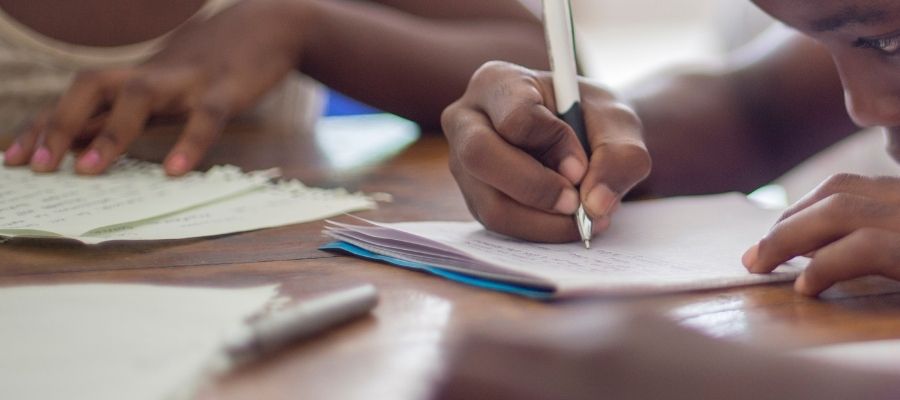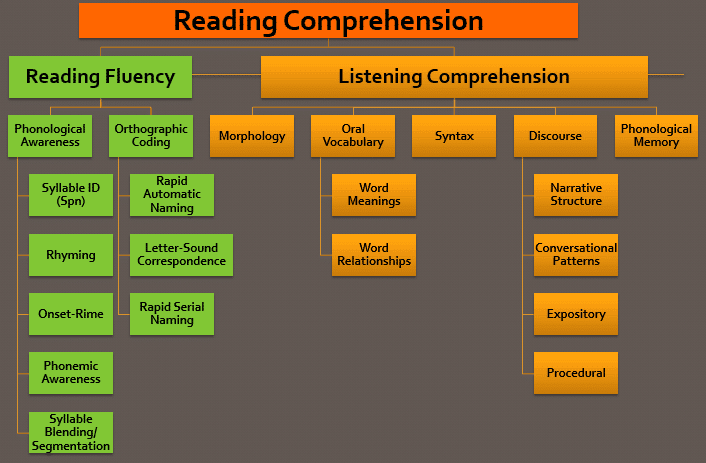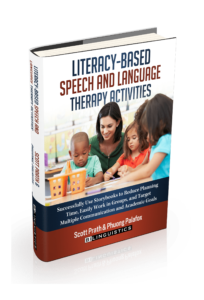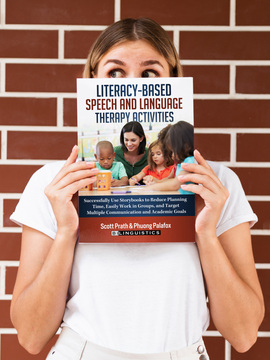In our jobs, it is the expectation that we address the greatest needs of the classroom. That is what special education is for right? To support and enable academic growth.
We spend a lot of time looking for ways to further support our little guys. When it comes to literacy, I would like to make the case that speech therapy and literacy goals already overlap and we are already doing a pretty good job. However, we probably aren’t doing a good job letting people know just how well we are supporting them.
Take a look at this chart. Any of these words look familiar to you?
Of course they do. Speech therapy and literacy goals are often one in the same. In this post, let’s talk a little bit about literacy. Then in next week’s post, we will present all the ammunition you need to show how your hard work ALREADY supports literacy.
Flex your Language Expertise

Understanding the symbiotic relationship between reading difficulties and communication development helps practitioners design and implement appropriate intervention programs for monolingual and bilingual children. Many students who exhibit communication disorders often have difficulties acquiring reading skills. By understanding language development and reading skill acquisition, therapy can be targeted to meet underlying oral language needs in conjunction with reading fluency and comprehension skills. Such an approach enables SLPs to apply language expertise to struggles in reading.
One of the key goals in elementary education is teaching children to read. Acquiring reading skills is based on two basic areas:
Decoding
In early elementary school, instruction focuses on learning phonemes, rhyming and decoding simple words to apply meaning. As children reach the later elementary school years, students have developed reading fluency, the ability to decode with fluidity, and are building their syntax, semantics and discourse skills. Reading acquisition requires the integration of many skills, including but not limited to, sound-symbol awareness, automaticity in word recognition, vocabulary skills, and understanding of morphological and syntactic structures. Reading skills also transfer to writing skills in which children apply knowledge of sounds to write words, and practice their knowledge of morphology and syntax to formulate sentences to describe, define, and analyze. A variety of resources show that children’s elementary reading abilities are used as predictors for future reading abilities, high school dropout rates, and the ability for children to communicate effectively, (Lipka, 2007; Morais, 1998).
Comprehension
Another element of reading success is related to reading comprehension. Some language models show that while reading fluency and decoding skills are a component of reading comprehension, children also need to gain knowledge of morphology, oral vocabulary, syntax, phonological memory and aspects of discourse, (Teal, 1986). Children need to understand the structures, actively access vocabulary, and interpret incoming information from spoken and written sources, (Lesaux, 2003).
Because reading abilities require the application of a spoken language system to a written system, many spoken language skills are already targeted in speech therapy and literacy. This is how we help build a foundation for stronger reading skills.
Where Speech Therapy and Literacy Meet
In order to best support students with speech, language and reading deficits, we need to address reading and writing foundations. Assessing our intervention and modifying the focus of intervention can ensure more effective outcomes for student success with BOTH speech therapy AND literacy.
According to current research, children with speech and language difficulties often present with co-occurring reading difficulties, (Berninger, 2008), so speech language pathologists working in all settings, but especially in schools, can support students’ reading acquisition and comprehension through their intervention.
Children with language delays often need more frequent instruction that is shorter in duration, and can also benefit from modifications in complexity to accommodate language processing, (Verhoeven, 2004).
More Reading:
ASHA has some great resources: ASHA’s Literacy Gateway (Reading and Writing)
Content for this essay adapted from Literacy-Based Speech and Language Activities. Use it to learn how to create powerful language therapy using predictable books.
References:
- De Jong & Van der Leij, 1999; Dufva, Niemi & Voeten, 2001; Muter & Snowling, 1998; Parila et al, 2004; Scarborough (Phonological memory is only weakly correlated with reading ability).







I am a recently Retired Public School Speech Language Specialist with 40 years experience. Most of my Language goals & IEPS covered the areas you mentioned, whether my students had Language delays or other classifications. I saw their reading & comprehension as well as CRITICAL THINKING SKILLS improve tremendously.
Your experience shows which direction I think most SLPs move as their career goes on. Kudos to you for leaning in to the classroom. Hopefully new comers to the field can jump on this bandwagon earlier and some themselves loads of time and effort. Thanks for sharing!
We start building literacy and language as early as the preschool classroom! In the Language Acquisition Preschool at the University of Kansas, in addition to building oral language and introducing the alphabetic principle, we promote literacy events where we portray that print plays an important role in activities of daily living. We offer many opportunities for natural literacy (i.e. using name cards during roll call songs, labeling cubbies and snack chairs with the children’s names, making books readily visible and accessible, having a lending library, acting out stories, etc.), and we promote literacy events in the dramatic play activities that we set up for our preschoolers to engage in daily (i.e. making shopping lists, taking an order, signing in at the doctor’s office, opening or sending mail, writing down a recipe, etc.). This semester we also introduced a Tier 2 Word of the Day using a “knock-knock box” format – the word chosen is in some way tied to our main dramatic play activity of the day, and the children are learning and retaining so much! We have children with SLI, limited English proficiency, and typical peers in our classroom.
my daughter has been stutters since she was 4 years old. She is been going to speech therapy for long time. Her latest SLP recommended for her to do speech literacy therapy. She is 12 years old now and she has been having problem with her language art subject at school. is it speech language literacy a good idea for her?
Hi there,
We are big fans of literacy-based intervention and do use it for clients who are disfluent (stutter). Think of your daughter’s entire communication. There are the words she is using (language), there are the sounds she is making to be understood (articulation) and there is the rhythm of her message (fluency/stuttering) as three main components. Any chance she can work on her fluency is real life situations is better because that is where she will have to practice the tools she learns. For example, she could be taught how to make her speech smooth/less bumpy/begin softly. Then she can practice her strategy by doing introductions, greetings, giving presentations, reading a book, telling a story, telling a joke, anything that would naturally be part of her day. Literacy-based intervention is a huge component of an academic day so this is a great way to practice fluency-shaping techniques.
Can you please help me understand the differences between the roles of a SLP and reading Specialist in the school setting?
Hi Christa,
There is some overlap in what we do but overall the goals of reading specialists and speech language pathologists are pretty different. When a child has a langauge disorder and it is related to expressive and/or receptive language, the goals can include:
Answering WH questions
Correctly sequencing a story
Including cohesive elements (first, then, after, at the end)
Including narrative aspects (setting, characters, problem, solution…)
So you can see that in essence, this can be gained from reading but can also be obtained without reading.
Reading Specialists have metrics around fluency, speed, words-per-minute, accuracy, comprehension.
Their goal is to get someone to be able to read and understand.
There is a lot of overlap in what we do because SLPs use storybooks to reach their communication goals. We lean in on whatever reading abilities a student has but we don’t qualify for special education if a child’s reading is below level. We can REALLY help the reading specialist make gains by using literacy-based intervention (eg. having our therapy revolve around storybooks) so that what they teach and what we teach aligns.
I hope that helps. Not sure what class you are teaching but professors are using our courses as part of their course curriculum. We have over 60 online course and a really good one on literacy-based intervention.
You can read more here: University Curriculum
And: Literacy Based Intervention Step by Step
Best Regards,
Scott Prath